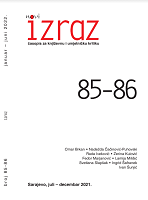Poetika vezanog stiha: od oblika do prepjeva
The Poetics of Bound Verse: From Form to Verse Translation
Author(s): Omar BrkanSubject(s): Poetry, Translation Studies, Theory of Literature
Published by: P.E.N. Centar Bosne i Hercegovine
Keywords: rhyhmed verse; interpretation; meaning; poetic form; poetry translation;
Summary/Abstract: The aim of this paper is to explore new possibilities when it comes to interpretation, meaning and translation of rhymed verse poetry. To reach that goal it was necessary to examine terms of interpretation and meaning in literature and poetic texts, the importance and function of poetic forms, as well as some of its specific stylistic effects. The thesis that supports the relatively defined and stable meaning of linguistic material within certain context is opposed to the one that assumes the possibility of endless interpretation of literary texts, and fluidity of its semantic borders. Thoughts in the first chapter are based on principles and arguments which Umberto Eco propounds in discussion with Richard Rorty and Jonathan Culler, summarised in the book Interpretation and Overinterpretation. It is well known that the interpretation precedes every translation act, and the translator, once found on a slippery ground of semantic variability (especially with poetry), must make a number of choices and decisions. And it is quite possible to make a mistake during that process. Sometimes that mistake is caused by a specific linguistic and formal requirement of the text, but more often it happens out of negligence, through a bad understanding of verse, phrase, figure or context. In the second chapter the focus is on the bare nature of poetic forms, on their capability of semantic impact (squarely or indirectly), on the question to what degree can poetic form alone speak about substantial layers of a concrete poem. Svetozar Petrović’s verse study given in book The Form and the Meaning provided crucial significance and benefit for this research. Sonnet, tercet, epic decasyllable, three-parted dodecasyllable and free verse, respectively, were observed in shorter essays. At the end of this paper I will offer some notices about function and usage of rhyme and enjambment, and frequent manners in poetics of rhymed verse, important for the translation technique of such and similar forms.
Journal: NOVI IZRAZ, časopis za književnu i umjetničku kritiku
- Issue Year: 2022
- Issue No: 85-86
- Page Range: 3-31
- Page Count: 29
- Language: Bosnian

